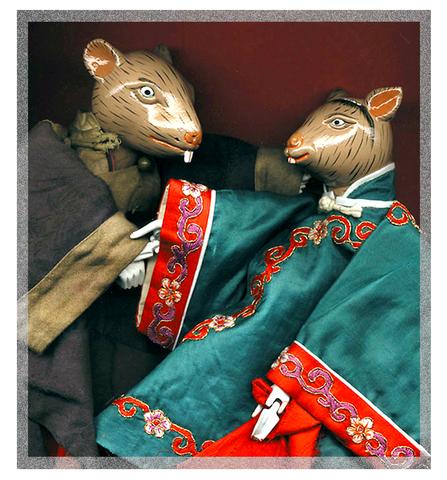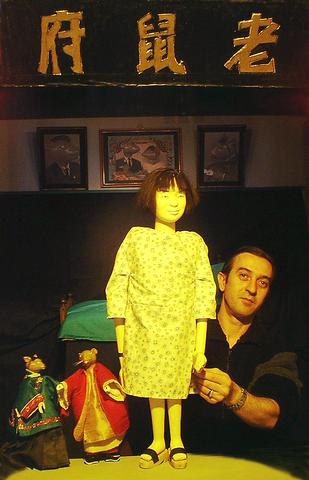Puppetry is one of Taiwan's most important folk arts, and even now that its heyday has passed, it continues to exercise a powerful influence on local culture. In order to bring it into the modern world, puppeteers have sought to incorporate all kinds of new elements, some more successfully than others. Probably some of the boldest experiments, albeit on a small scale, are being conducted by the TTT Puppet Centre in Taipei. They are introducing a new show, The Wedding of the Mice
The Wedding of the Mice is based on a traditional Chinese New Year fable but has been extensively reworked to give it a stronger appeal to a modern audience. "We don't want it to be something like a legend, which is distant [from the audience]," said Wu Shan-shan

The story begins with an old lady remembering a wonderful experience of her childhood. When she was little girl, she accidentally entered the Mouse Mansion. She overheard that two young mice lovers were going to be separated. The young mouse girl is the daughter of the lord of the Mouse Mansion and she is deeply in love with the young and poor inventor A-lang. The young girl is sympathetic to their plight and figures out cunning ways to help the lovers be together, convincing the father of the girl that A-lang should be her husband. The play ends with the wedding festival of the mice, which traditionally takes place on the third day of the Chinese New Year. On this day, all Chinese children have to be quiet all night because the mice are having a wedding.

PHOTO COURTESY OF TTT
"We introduced the character of the little girl to give the story something to which children could relate to in their own experience," Wu said. The performance adopts a storytelling format, with Wu telling the story as the action takes place on stage. This follows on from a tradition in which the human performers interact with the puppets on a stage that was used in the puppet center's previous show, Marco Polo. This earlier show, which met with considerable success and has been invited to perform by the Obraztsov Central State Academic Theater in Russia and will also play at the Festival Internationale Del Teatro Per Ragazzi in Porto S. Elpidio in Italy, combines nankuan areas and Italian opera to tell a story of Marco Polo's adventures in China.
While there is less of an Italian flavor in The Wedding of the Mice -- it is a Chinese New Year puppet show after all -- the cultural mix is equally innovative. For the mice characters, traditional Taiwanese glove puppets are used, but the little girl is a much larger rod puppet which is manipulated by Italian puppeteer Massimo Godoli Peli, who also worked on Marco Polo. There are also three Mafia mice in the current show created by Peli, who favors the most traditional materials, making the puppets from a mixture of rag, glue, flour, eggs and vinegar.
While The Wedding of the Mice crosses many cultural boundaries, both Peli and Robin Ruizendaal, the show's director, emphasize the need to work from tradition. "Of course we follow tradition, but we are also constantly developing something else. Otherwise you are just specializing in one thing, doing the same thing for 20 years; it is no different from working in a bank," Peli said. He is currently working on a new show in which he brings two Italian stock comic characters to Taipei, where they proceed to make all kinds of rumpus.
While this project aims for the raucous violence and crude humor of a Punch and Judy show -- with echoes of Ah Chung Puppet Theater, who created puppetry in a contemporary Taiwanese vernacular -- The Wedding of the Mice goes for the lyrical touch very suitable to the intimate space of the TTT Puppet Centre where it will be performed.
According to Bart Roccoberton Jr, a professor of puppet arts at the University of Connecticut, puppets actually feature heavily in modern advertising and stage performance, and in some respects, the high status given to puppetry as an "art form" can get in way of its acceptance by a wider public. By bringing together a number of diverse traditions, hoary old authenticity is put aside and the freshness and creativity of various art forms can be more readily expressed.
What: The Wedding of the Mice
Where: TTT Puppet Centre, 66 Minle Street
(near the intersection Tihua Street
and Minsheng W. Rd.)
When: Tomorrow and Sunday; Feb. 5, 6, and 7,
at 2pm and 4pm
Entrance fee: NT$80 for adults; NT$50 for children
Language: Mandarin (English synopsis provided;
the play is easy to follow for non-Mandarin speakers
Duration: 30 minutes

Desperate dads meet in car parks to exchange packets; exhausted parents slip it into their kids’ drinks; families wait months for prescriptions buy it “off label.” But is it worth the risk? “The first time I gave him a gummy, I thought, ‘Oh my God, have I killed him?’ He just passed out in front of the TV. That never happens.” Jen remembers giving her son, David, six, melatonin to help him sleep. She got them from a friend, a pediatrician who gave them to her own child. “It was sort of hilarious. She had half a tub of gummies,

June 23 to June 29 After capturing the walled city of Hsinchu on June 22, 1895, the Japanese hoped to quickly push south and seize control of Taiwan’s entire west coast — but their advance was stalled for more than a month. Not only did local Hakka fighters continue to cause them headaches, resistance forces even attempted to retake the city three times. “We had planned to occupy Anping (Tainan) and Takao (Kaohsiung) as soon as possible, but ever since we took Hsinchu, nearby bandits proclaiming to be ‘righteous people’ (義民) have been destroying train tracks and electrical cables, and gathering in villages

Swooping low over the banks of a Nile River tributary, an aid flight run by retired American military officers released a stream of food-stuffed sacks over a town emptied by fighting in South Sudan, a country wracked by conflict. Last week’s air drop was the latest in a controversial development — private contracting firms led by former US intelligence officers and military veterans delivering aid to some of the world’s deadliest conflict zones, in operations organized with governments that are combatants in the conflicts. The moves are roiling the global aid community, which warns of a more militarized, politicized and profit-seeking trend

The wide-screen spectacle of Formula One gets a gleaming, rip-roaring workout in Joseph Kosinski’s F1, a fine-tuned machine of a movie that, in its most riveting racing scenes, approaches a kind of high-speed splendor. Kosinski, who last endeavored to put moviegoers in the seat of a fighter jet in Top Gun: Maverick, has moved to the open cockpits of Formula One with much the same affection, if not outright need, for speed. A lot of the same team is back. Jerry Bruckheimer produces. Ehren Kruger, a co-writer on Maverick, takes sole credit here. Hans Zimmer, a co-composer previously, supplies the thumping